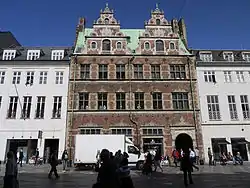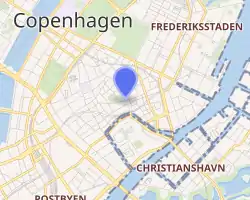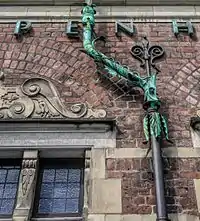Matthias Hansen House
The Matthias Hansen House (Danish: Matthias Hansens Gård), formerly also known as the Schoustrup House (Danish: Schoustrups Gård) is a Renaissance-style townhouse on Amagertorv (No. 6) in central Copenhagen, Denmark. Built in 1616, it is one of few buildings of its kind which has survived the Copenhagen Fires of 1728 and 1795. The building is now home to a flagship store for the Royal Copenhagen porcelain factory.[1][2]
| Matthias Hansen House | |
|---|---|
Mathias Hansens Gård | |
 Matthias Hansen House at Amagertorv | |
 | |
| General information | |
| Architectural style | Renaissance |
| Location | Amagertorv, Copenhagen |
| Country | Denmark |
| Coordinates | 55°40′44.17″N 12°34′44.56″E |
| Completed | 1616 |
History
.png.webp)
The house was built in 1616 for Matthias Hansen, who was a member of the city council and later served as mayor of Copenhagen from 1622 until his death in 1626. Hansen's daughter, Kirsten Madsdatter, was one of Christian IV's mistresses and mother of Christian Ulrik Gyldenløve. Later residents include the composer Emil Hartmann, who lived there first in 1846 and again in 1852.[3]
The insurance company Hafnia acquired the building in 1872 and made it their headquarters. Architect Hans Jørgen Holm refurbished the building in 1898 and a café designed by Thorvald Bindesbøll opened on the ground floor the following year. In 1912, Hafnia relocated to a new building on the corner of Holmens Kanal and Holbergsgade in Gammelholm. The building on Amagertorv was then taken over by the porcelain manufacturer Aluminia, which was merged with Royal Copenhagen in 1962.[3]
Architecture

The building consists of three storeys and a cellar and stands in blank red brick with sandstone decorations. The facade is six bays wide and topped by a double Dutch gable. The gateway opens to a courtyard space which affords access to a rear wing and a connecting wing. The octagonal staircase tower in the courtyard is a reconstruction of a staircase tower which was demolished in 1731.[3]
List of owners
- 1616–1628: Matthias Hansen
- 1628–ca. 1660: Ingeborg Leiel Frederiksdatter (widow)
- ca. 1660–1663: Hans Matthiassen Mechlenburg (son)
- 1663–1666: Margrethe Rosenmeyer Henriksdatter (widow)
- 1666–1670: Ingeborg Margrethe Mechlenburg, married to Royal Commissioner (kgl. kommissarius) Frants Müller from Gundetved, who became owner through marriage
- 1670–1677: Diderik Schult, Privy Councillor (gehejmeråd), executive secretary (oversekretær) for the Danish chancellery, etc.[4]
- 1677–1677: Gerhard Schrøder, nephew of Peder Schumacher Griffenfeld's mother
- 1677–1693: Marie Fuiren, widow of Archbishop Hans Svane
- 1693–unknown: Anne Margrethe Svane (daughter), widow of council advisor (kancelliråd) and city doctor (stadsfysikus) Jens Foss (died 1687), and Søster Svane (daughter), widow of bishop Hans Bagger
- unknown–1727: Johan Sohl, wine merchant, one of the assembly of 32 Men mentioned in Ludvig Holberg's comedy Den vægelsindede. He was married to a sister of the later-mentioned Johan Henrik Syling and presumably died in 1727, when the house was sold
- 1727–unknown: Andreas Matthiesen and co-interests
- unknown–1731: Johan Henrik Syling, commerce minister (kommerceråd), brother-in-law of Johan Sohl. On the same occasion, the sale of a garden plot belonging to the property probably took place in January 1728. As it seems, the farm was sold again in 1731 after a claim from a mortgagee, Andreas Brun.
- 1731–1738: Otto von Blome, Privy Councillor (gehejmeråd)
- 1738–1740: Anna Sophie Schack, widowed countess
- 1740–1752: Gregorius Klauman, Justice Minister and bank commissioner, etc., later honorary council of state (etatsråd)
- 1752–1762: Knud Gregorius de Klauman, mayor, etc. (son)
- 1762–1763: Ulrikke Sophie de Klauman (widow)
- 1763–1795: Christian Hansen, wholesaler, one of the 32 Men
- 1795–1814: Jens Schoustrup, wholesaler
- 1814–1818: Peter Schoustrup, wholesaler, and Johan Henrik Schoustrup, grocer (sons)
- 1818–1844: Johan Henrik Schoustrup
- 1844–1872: Peter Jacob Schoustrup, wholesaler and vinegar brewer (son)[5]
- 1872–1912: The insurance company Hafnia
- 1912–1997: The royal porcelain factory, now Royal Copenhagen
- 1997–present: Royal Scandinavia
References
- Sommer, A.L. (2009). Den danske arkitektur (in Danish). Gyldendal. p. 143. ISBN 978-87-02-05401-9. Retrieved 3 March 2018.
- Tönnesen, A. (1979). 233 danske borgerhuse (in Danish). Gyldendal. p. 13. ISBN 978-87-01-54131-2. Retrieved 3 March 2018.
- "Amagertorv 6". indenforvoldene.dk. Retrieved 7 March 2013.
- "Diderik Schult | lex.dk". Dansk Biografisk Leksikon (in Danish). Retrieved 1 May 2021.
- Fra 1616 til 1852 er ejerlisten baseret på: "Den Becherske og den Schoustrupske Gaard i Kjøbenhavn: Et Bidrag til Stadens Huuseiendoms- og Bygningshistorie", Nyt historisk Tidsskrift, bind 5 (1854). Online hos Google Books
External links
- "Fredede Bygninger Marts 2018" [Listed Buildings March 2018] (PDF) (in Danish). Slots- og Kulturstyrelsen. Archived (PDF) from the original on 3 March 2018. Retrieved 3 March 2018.
| Wikimedia Commons has media related to Matthias Hansens Gård. |